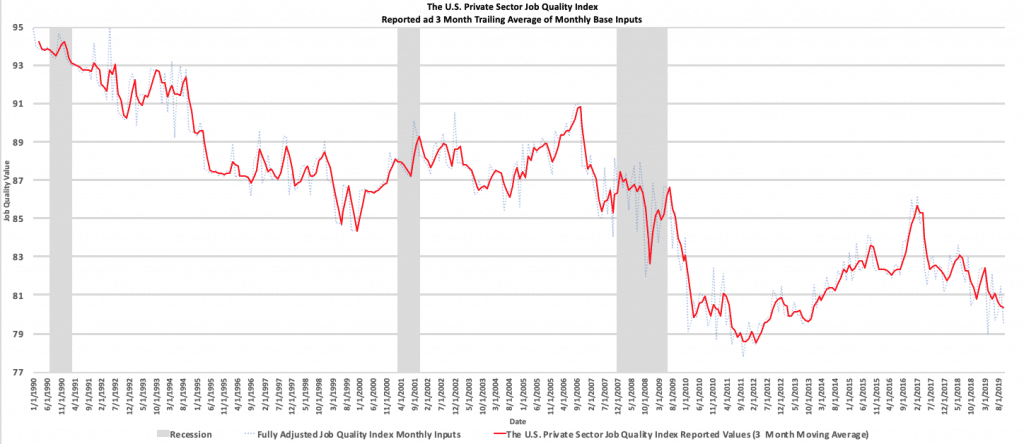Most of us spend a great part of our time at work, and work for a considerable part of our lives. Therefore, the quality of our job determines to a great extent our quality of life.
Being able to find and hold a job is important to ensure our livelihood, but it is not enough. The quality of that job matters too. Employment allows us to make a living, but what kind of a living?
What is decent work?
Decent work sums up the aspirations of people in their working lives.
It involves opportunities for work that is productive and delivers a fair income, security in the workplace and social protection for families, better prospects for personal development and social integration, freedom for people to express their concerns, organize and participate in the decisions that affect their lives and equality of opportunity and treatment for all women and men.
So, decent work is closely related to employment quality.
Promoting decent work around the world is at the heart of the ILO’s mandate. The ILO’s Decent Work Agenda has 4 pillars:
- Job creation
- Fundamental principles and rights at work
- Social protection
- Social dialogue
Gender equality is a cross-cutting objective within the ILO’s Decent Work Agenda.
The Sustainable Development Goals (SDGs) are the blueprint for global and sustainable development. The 17 Goals address social, economic and environmental challenges including those related to poverty, inequality and climate change.
Achieving decent work in labour markets around the world is part and parcel of the SDGs.
The measurement challenge
In order to conduct high-quality labour market research and design effective labour market policies, we need good data. Some of the most widely used labour market indicators (such as the employment-to-population ratio and the unemployment rate) refer to the quantity of employment (and unemployment) in an economy. However, a comprehensive analysis of the labour market requires data on employment quality as well.
Unfortunately, measuring employment quality is not an easy task.
So many aspects make up the quality of our employment that it is hard to decide which ones to consider, and how to consider them. These include remuneration, working time, social security coverage, the type of contract, the degree of job security, access to paid leave, parental leave, and sick leave, and career advancement opportunities, to name a few.
Many frameworks attempt to measure quality of employment
These frameworks are lists of indicators designed to give a comprehensive picture of employment quality.
The ILO Decent Work Indicators are a set of 75 statistical and 21 legal framework indicators aimed at measuring decent work. They pertain to ten main elements: employment opportunities, adequate earnings and productive work, decent working time, combining work, family and personal life, work that should be abolished, stability and security of work, equal opportunity and treatment in employment, safe work environment, social security, and social dialogue.
Data on the main statistical decent work indicators is available on ILOSTAT. This manual incudes methodological information on this measurement framework.
The SDG Global Indicator Framework includes 232 indicators for monitoring progress towards the achievement of each of the goals and targets of the Sustainable Development Agenda.
Within this list, close to 20 indicators pertain to decent work and thus provide an idea of employment quality.
ILOSTAT provides data and methodological information on the SDG labour market indicators.
The OECD Framework for Measuring and Assessing Job Quality is structured around three elements:
– earnings quality
– labour market security (which includes indicators on unemployment risk and unemployment insurance)
– quality of the working environment (which includes indicators on physical health risk factors, long working hours, inflexibility of working hours, work autonomy and learning opportunities, and opportunity for career advancement).
Data on the three composite elements and on the individual indicators is available in the OECD Job quality database. Methodological information on the framework is provided in this paper.
This statistical framework by the United Nations Economic Commission for Europe provides a coherent set of indicators for measuring quality of employment, divided into seven dimensions and twelve sub-dimensions:
1) Safety and ethics of employment
a) Safety at work
b) Child labour and forced labour
c) Fair treatment in employment
2) Income and benefits from employment
a) Income
b) Non-wage pecuniary benefits
3) Working time and work-life balance
a) Working hours
b) Working time arrangements
c) Work-life balance
4) Security of employment and social protection
a) Security of employment
b) Social protection
5) Social dialogue
6) Skills development and training
7) Employment-related relationships and work motivation
a) Employment-related relationships
b) Work motivation
Information on this framework is available here.
The European Foundation for the Improvement of Living and Working Conditions (Eurofound) conducts every five years the European Working Conditions Surveys, which provide an overview of working conditions in Europe.
The ILO and the Eurofound partnered to extend these surveys to other countries. Through this joint project, they collected and analysed comparable data on working conditions around the world. Seven dimensions of job quality were considered: the physical environment, work intensity, working time quality, the social environment, skills and development, prospects, and earnings.
This report presents the key findings of this pioneering project.
But these frameworks are not indexes. They do not provide one composite measure allowing us to assess the degree of employment quality. Instead, they present a range of indicators reflecting various dimensions of employment quality, which need to be interpreted together.
The U.S. Private Sector Job Quality Index
The U.S. Private Sector Job Quality Index (JQI) is a composite measure of two key aspects of working conditions in the United States, namely wages and working time.
The first step to producing this index is establishing a benchmark value for wages and hours of work based on the weighted average of all jobs data available. Then, jobs in each industry group are categorized into low or high quality by comparison to the benchmark. If an industry’s wage and working time are below the benchmark, then its jobs are low quality. If an industry’s wage and working time are above the benchmark, then its jobs are high quality.
The JQI is the ratio of the total number of high-quality jobs to the total number of low-quality jobs. A JQI of 100 means that there are as many low-quality jobs as high-quality ones. A JQI of less than 100 implies that there are more low-quality jobs than high-quality ones, and the opposite would be true for a JQI above 100.
This is a valuable summary measure of employment quality in the US labour market, but it is an incomplete one. As useful as this index is for labour market trend analysis, by focusing only on wages and working time, it disregards many other key aspects of employment quality. In that sense, the name of the index may mislead us into interpreting it as an encompassing measure of employment quality.
What is more, we must keep in mind that this index is a relative measure: jobs are classified as low-quality or high-quality based on the average job quality. Therefore, even in an economy where all jobs are decent some would be classified as low-quality compared to the average. And even in an economy where all jobs are inadequate some would be classified as high-quality. In this sense, it is best to study the JQI’s trend rather than its value on a given point in time.
Measuring quality of employment in short
- Employment quality is multidimensional. Measuring employment quality means measuring numerous aspects of working conditions.
- Measuring all these aspects requires an integrated system of labour statistics including various types of sources.
- Statistical indicators must be complemented with legal framework indicators to place the labour market analysis within the corresponding context.
Author
-
Rosina Gammarano
Rosina is a Senior Labour Statistician in the Statistical Standards and Methods Unit of the ILO Department of Statistics. Passionate about addressing inequality and gender issues and using data to cast light on decent work deficits, she is a recurrent author of the ILOSTAT Blog and the Spotlight on Work Statistics. She has previous experience in the Data Production and Analysis Unit of the ILO Department of Statistics and the UN Resident Coordinator’s team in Mexico.














